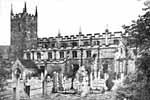For this church:    |
|
 Gates near the Gates near the south door |
 The south entrance to The south entrance tothe churchyard |
At the present time, there are wrought iron railings to the north of the church, continuing westwards down to the south-west corner of the churchyard. The gates near the south door of the church were replaced in 1992 and were in memory of William (Bill) G Skinner.
A stone wall forms the southern boundary. By the end of 1901, it was in poor repair and the Church Council entered into negotiations with the West Bridgford Urban District Council on its repair. The Church Council resolved to put in oak gates and make electrical connections so that a lamp could be placed on either or both of the gate pillars.
The eastern boundary, working northwards, is formed by the cottages (owned by the church as the Croft Estate and the oldest dwellings in West Bridgford), a hedge by the new rectory, and wooden fence by other houses.
 The churchyard in The churchyard inthe 1950s |
 1963 plan 1963 plan |
In 1951, a faculty was granted to level all neglected graves and remove unsafe gravestones to the boundary. The photograph, used on the cover of the parish magazine in the 1950s, shows the abundance of headstones remaining.
A further programme of moving gravestones and laying others down was embarked upon in 1963. As part of this programme, a plan was drawn-up to show the existing location of gravestones before the work commenced.
 The eastern section The eastern sectionof the churchyard |
 The western section The western sectionof the churchyard |
Today, there are comparatively few gravestones remaining in the churchyard.
In 1983, a faculty was granted to set aside an eastern part of the churchyard for the interment of cremated remains, with the proviso that 'there would be no visible markings of any interment'. A plaque was placed nearby on the church wall in 1997:
GARDEN OF REMEMBRANCE
 WHOSE NAMES APPEAR IN THE BOOK OF REMEMBRANCE HELD IN THE CHURCH |
At this time, it was stated that the last recorded burial was in 1959 and the Department of Environment confirmed they had no records of any Order discontinuing burials in the churchyard. In fact, the church had applied for an Order in Council to close the churchyard to burials in 1962, in the hope that the borough council would then take on responsibility for cutting the grass. However, the council refused to support the application. The borough council assessed the area of the churchyard as 3,215 square yards: two-thirds covered with gravestones and monuments, the other one-third grassed.
Memorial Benches
There are four wooden benches in the churchyard.
Faith Severn
| IN MEMORY OF FAITH SEVERN 1937-1991 |
Faith was the wife of John Severn who started the Southwell and Nottingham Church History Project.
Stanley and Tricia Ellwood
| In Memory of Stanley Ellwood Father of Tricia 9th September 1916 - 26th July 2009 |
and
| In Loving Memory of Tricia Ellwood 14th June 1947 - 15th March 2001 |
Michael Waring
| IN LOVING MEMORY OF MICHAEL JOHN WARING 4.10.37 – 23.2.96 |
Stephen Ellis
| Stephen Derek Kingscote Ellis 1953 – 2015 |
and, on the seat
| Gerrie ter Haar |
Grave-Markers
 Grave marker Grave marker to Robert Clerk |
When the graveyard was mapped in 1963, a list was made of the grave-markers and cross-referenced to the plan. An earlier list of epitaphs, compiled by Phillimore, was published in 1877. In both lists, the earliest entry was for Robert Clerk who died in 1705. This is a slate headstone of the kind known as 'Belvoir angels'and is to be found at the west side of the south porch.
There is a verse on the gravestone:
| You readers all both old & young Your time on earth will not be long For death will come & die you must And like me return to dust |
The mason must have miscalculated his spacing, as the word 'long' had to be inserted above the rest of the line.
A grave-marker inside the ancient chancel records those graves lost as a result of the church extension.
When Throsby visited at the end of the 18th century, he found a gravestone for John Billings, who had died in 1785 at age 82, near the church door. This does not seem to have survived. It bore the inscription: 'He fell like Autumn Fruit, that mellowed long, Much wondered at because he dropt no sooner. Fate wound him up for three score Years and ten; Yet freshly run he on some Winters more, Till like a Clock, worn out with beating time, The Wheels of weary Life, at length, stood still.'
The most noticeable grave marker now is formed by the yew tree and kerb stones by the south porch. It marks the graves of the Heymann family who lived in Bridgford Hall.
There is a headstone erected by the Commonwealth War Graves Commission in 1974, which reads '2952 Rifleman A.C. Lacey King's Royal Rifle Corps 10th October 1915 Age 20'.










